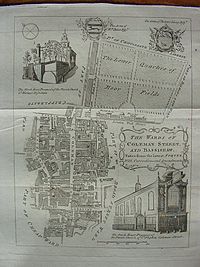Bassishaw
Bassishaw is a ward in the City of London. This small ward is bounded on the east and south, by Coleman Street ward; on the north by Cripplegate ward; and on the west by Cripplegate and Cheap wards. It consists only of Basinghall street with the courts and avenues leading into it[1].

History
Etymology
The ward is named for Basinghall, the mansion house of the Bassing family, who were prominent in the city from the 13th century[1]. Henry III granted Adam de Bassing certain houses in Aldermanbury and in Milk-street; the advowson of the church at Bassings hall; with other liberties and privileges. The family also spread in Cambridgeshire and gave their name to a place called Bassingbourn.
Guilds and church
Located in this ward was a weekly cloth market, granted by Richard III. The Coopers' guild hall was first founded in this ward in 1522, at The Swan and from 1547, a purpose built hall. Their hall was destroyed in the Great Fire of London in 1666, and rebuilt on the same site. They rebuilt again in 1865, selling a part of the site to the Corporation for the expansion of Guildhall. This hall was destroyed by fire on the night of 29th December, 1940[2].
The Masons' hall was constructed in 1463 in Mason's Avenue. Their hall was also sold to the Corporation in 1865. The Weavers', and Girdlers' also had their guild halls in the ward[1].
There was only one church in this small ward, named St. Michael Bassishaw, dedicated to St Michael the archangel, founded about 1140. At that time the rectorship was in the gift of St Bartholomew-the-Great, but over time came to be associated with St Pauls Cathedral. The church was destroyed in the Great Fire of London, and rebuilt in 1679[1]. It was united with St Lawrence Jewry in 1897, and the site sold in 1899 and the church demolished in 1900.
References
- ^ a b c d 'Book 2, Ch. 6: Bassishaw Ward', A New History of London: Including Westminster and Southwark (1773), pp. 549-51 accessed: 21 May 2007
- ^ History of the Coopers accessed 21 May 2007
